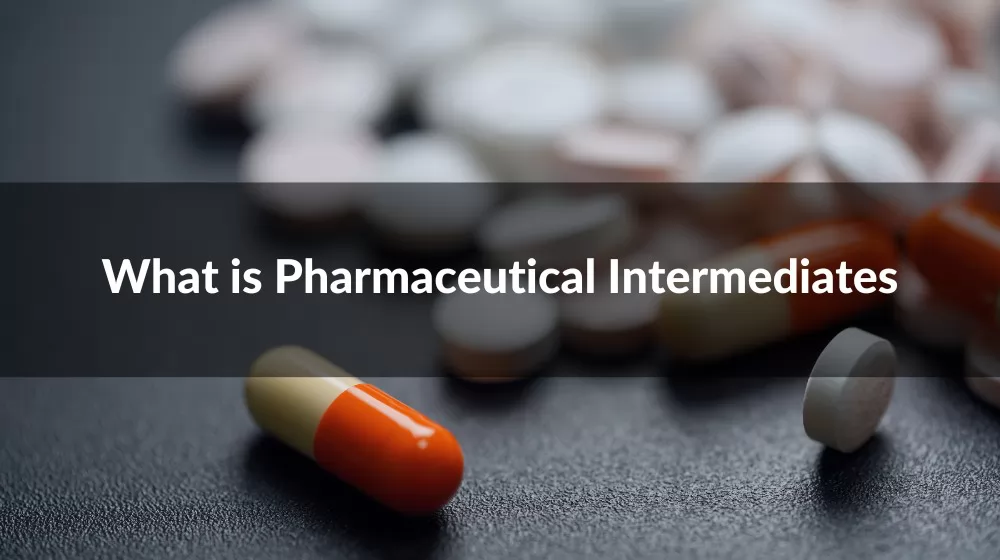

Unveiling the World of Pharmaceutical Intermediates – the silent but critical players in the healthcare industry. It's these unsung heroes that empower the leap from scientific breakthroughs to life-saving drugs. In this journey, pharmaceutical intermediates serve as the fundamental building blocks that catalyze the development of innovative therapies. Let's embark on a discovery trail to understand what these substances are, their types, and their vital roles in medicinal chemistry. With industry-leading insights, we'll explore how pharmaceutical intermediates are shaping the future of therapeutic development, under the expertise of pioneers like China's HighMountain Chem.
When we talk about pharmaceutical intermediates, we're referring to the critical chemical compounds that serve as the building blocks in the production of active pharmaceutical ingredients (APIs). They are pivotal stages in the complex synthesis of medications, where a raw substance undergoes several chemical reactions before emerging as an API. Their role is essential, as they can significantly influence the structure, quality, and efficacy of the final pharmaceutical product.
The significance of pharmaceutical intermediates cannot be overstated. They are not just a cog in the wheel of drug development; they are the wheel itself. Each intermediate step must be carefully controlled and monitored to ensure the purity and safety of the medication. As such, intermediates are a testament to the innovation and complexity of the pharmaceutical industry, ensuring that new, effective drugs can reach the market faster, safely, and more reliably.
The market for pharmaceutical intermediates is a dynamic and vital part of the pharmaceutical supply chain. With the continuous advancement of medical science, the demand for more specialized and high-quality intermediates is rising. This market is driven by the need for efficient and cost-effective drug production, and it plays a crucial role in the accessibility of medicines globally. The players in this market range from large multinational corporations to specialized boutique chemical producers, each contributing to the development and supply of these essential components.
Building blocks are the foundational elements in the synthesis of pharmaceutical intermediates. These simple, yet versatile compounds possess reactive functional groups that enable them to be used in a variety of chemical reactions to construct more complex molecules. They are often used to start a synthetic pathway, laying down the skeleton of the eventual active pharmaceutical ingredient.
Advanced intermediates are complex molecules that stand just a few chemical transformations away from becoming APIs. They have undergone several synthetic steps and are poised for final modifications. These intermediates often require careful handling and sophisticated chemical reactions, reflecting the high level of precision needed in later stages of drug development.
Chiral intermediates are specialized molecules that have significant importance in the synthesis of enantiomerically pure drugs, which are compounds consisting of a specific orientation of their molecular structure. The chirality of a drug can greatly affect its efficacy and safety profile, making chiral intermediates critical for producing medications that are both effective and safe for patient use.
Linkers and side chains represent a category of intermediates that are used to connect different parts of a molecule or to modify existing structures to enhance a drug’s properties, such as its pharmacokinetic behavior or its biological activity. These components are essential for the fine-tuning of a molecule's function and represent a critical aspect of pharmaceutical synthesis.
The development of a new drug is a monumental journey from an initial concept to a final product used in clinical settings. Pharmaceutical intermediates are the unsung heroes in this process. They are involved at multiple stages—from early research and discovery to the final stages of synthesis. Each intermediate acts as a checkpoint that must meet stringent criteria for purity, efficacy, and safety before advancing to the next phase of development, ultimately culminating in a drug that is ready for clinical trials and, ultimately, patient treatment.
A crucial objective in drug development is to enhance the therapeutic efficacy of a compound while minimizing its toxicity. Pharmaceutical intermediates play a critical role in this balancing act. By manipulating the intermediate compounds, chemists can fine-tune the pharmacological profile of a drug, enhancing its ability to interact with the intended target in the body while reducing its potential to cause adverse effects. This level of control is fundamental in the production of medications that are not only effective but also safe for consumers.
In the fast-paced realm of drug discovery, time is of the essence. Pharmaceutical intermediates can accelerate the drug discovery process by enabling chemists to quickly synthesize diverse libraries of drug candidates for screening. By having a supply of readily available, high-quality intermediates, the iterative process of drug design, testing, and modification becomes significantly more efficient, helping new drugs to reach the market faster, without compromising on safety or efficacy.
Biological systems offer a treasure trove of sources for the production of pharmaceutical intermediates. Microbes, with their diverse metabolic pathways, can produce complex molecules that serve as intermediates for further chemical synthesis. Similarly, enzymes, as biological catalysts, are utilized to carry out specific chemical reactions with high precision and efficiency, often under mild conditions that are more environmentally sustainable compared to traditional chemical methods. The use of biotechnology in the production of pharmaceutical intermediates is a growing field, offering greener alternatives and contributing to the advancement of green chemistry in the pharmaceutical industry.
Chemical synthesis remains the backbone of pharmaceutical intermediate production. This involves the construction of complex drug molecules through a series of chemical reactions, starting from simpler substances. Synthetic pathways are meticulously designed to optimize yield, purity, and cost-effectiveness. Advances in synthetic chemistry continue to streamline these processes, leading to more efficient routes that reduce waste and improve scalability. The skillful orchestration of these synthetic pathways is a hallmark of modern pharmaceutical manufacturing.
As the pharmaceutical industry evolves, the trend of outsourcing intermediate production has become increasingly prevalent. Contract Manufacturing Organizations (CMOs) and Contract Development and Manufacturing Organizations (CDMOs) have emerged as key partners in this domain. They offer specialized services that span the entire lifecycle of pharmaceutical production, from development to full-scale manufacturing. This outsourcing model allows pharmaceutical companies to leverage external expertise and state-of-the-art facilities, enabling them to focus on their core competencies of drug development and marketing, while CMOs and CDMOs handle the complex production processes.
In the pharmaceutical industry, the purity of intermediates is not just a goal—it's a mandate. Quality control (QC) is an intricate dance of precise procedures ensuring that every batch of pharmaceutical intermediates meets the highest standards. Rigorous testing for purity, potency, and absence of contaminants is conducted using state-of-the-art analytical methods. Quality assurance (QA) systems are also implemented to oversee the entire process, from raw material verification to in-process checks and final product release, to ensure compliance with the stringent standards set forth by regulatory authorities.
The global nature of the pharmaceutical market means that intermediates must adhere to a complex web of regulatory standards. These regulations vary from country to country but share a common objective—to ensure that pharmaceutical products are safe, effective, and of high quality. Companies must navigate the regulatory landscapes of the FDA in the United States, EMA in Europe, and other bodies worldwide. This includes compliance with Good Manufacturing Practices (GMP), proper documentation, and reporting procedures, which are critical for market authorization and maintaining a license to operate.
The certification process for pharmaceutical intermediates is a rigorous and comprehensive assessment that ensures conformity with regulatory requirements. Certifications such as the ISO standards provide a framework for quality management systems that a manufacturing facility must establish. Additionally, specific certifications like the Certificate of Suitability (CoS) or the Drug Master File (DMF) submission provide detailed documentation on the quality and production of the intermediates. These certifications are often a prerequisite for entering certain markets and are a testament to a company’s commitment to quality.
Process intensification techniques are redefining the efficiency and effectiveness of pharmaceutical intermediate manufacturing. These techniques aim to make dramatic improvements in manufacturing and processing, significantly enhancing productivity and sustainability. They involve the miniaturization of equipment, increased automation, and the optimization of reaction conditions to achieve higher yields with lower energy consumption and reduced waste. This not only supports the economic bottom line but also aligns with the increasing environmental and regulatory demands.
Green chemistry principles are being integrated into the production of pharmaceutical intermediates, pushing the envelope towards more sustainable practices. This approach prioritizes the use of non-toxic and renewable materials, waste reduction, and energy-efficient processes. Innovations such as biocatalysis, the use of safer solvents and reagents, and the development of alternative synthetic routes that minimize the environmental footprint are at the forefront of green chemistry in intermediates production.
Continuous flow chemistry is a transformative approach that has made a significant impact on the manufacturing of pharmaceutical intermediates. Unlike traditional batch processing, continuous flow involves the seamless processing of chemical reactions without interruption. This technology offers numerous advantages, including improved reaction control, enhanced safety, and the ability to scale up from laboratory to industrial production with ease. It enables manufacturers to produce intermediates more efficiently, with greater control over quality and a smaller physical footprint.
Cost factors in the production of pharmaceutical intermediates are diverse and multifaceted. They range from the expenses associated with raw materials to the costs of compliance with regulatory standards. Pricing models for intermediates need to account for these costs, along with the investments in technology and labor. Economies of scale often play a significant role; as production volume increases, the cost per unit can decrease, which is particularly relevant in the case of generic drug manufacturing. Companies must balance these factors carefully to remain competitive while ensuring a return on investment that can fund further research and development.
The supply chain dynamics of pharmaceutical intermediates are complex, as they involve a global network of suppliers, manufacturers, and distributors. The efficiency of this supply chain is critical, as delays or disruptions can have a ripple effect, impacting drug production and ultimately affecting patient access to medications. Strategic management of the supply chain, including risk assessment and the development of contingency plans, is essential for maintaining the steady and secure distribution of pharmaceutical intermediates.
Raw material costs are a significant component of the overall cost structure for pharmaceutical intermediates. Fluctuations in the price of these materials can have a direct impact on the cost of production. Factors such as geopolitical events, environmental regulations, and market demand for these raw materials all play a role in pricing volatility. Companies often hedge against these risks through strategic sourcing agreements and inventory management practices to buffer against price fluctuations and ensure a consistent supply.
The expiration of patents is a significant challenge for the pharmaceutical industry, particularly for the manufacturers of branded medications. As patents expire, generic manufacturers are allowed to produce and sell cheaper versions of the drug, which can drastically reduce the market share and profits of the original drug. For manufacturers of pharmaceutical intermediates, this shift can result in altered demand patterns, with a need to scale production up or down rapidly to meet the changing needs of generic drug producers.
Environmental concerns present a growing challenge for the pharmaceutical intermediate sector. The production process can generate significant amounts of waste, which must be managed and disposed of responsibly to minimize environmental impact. There is increasing pressure from both regulators and the public to adopt greener practices and reduce the ecological footprint of manufacturing processes. This includes the implementation of waste reduction strategies, investment in waste treatment technologies, and the exploration of more sustainable production methods.
Innovation is the lifeblood of the pharmaceutical industry, but it often comes with high costs. Developing new synthetic routes, investing in advanced manufacturing technologies, and ensuring the highest quality standards are all critical—but they require significant investment. Pharmaceutical intermediate manufacturers must balance the need for innovation with the demand for cost-effectiveness. This involves optimizing existing processes, scaling up new technologies efficiently, and continuously exploring cost reduction opportunities without compromising on the quality or efficacy of the intermediates produced.
Emerging markets represent a significant opportunity for growth in the pharmaceutical intermediates sector. As healthcare infrastructure improves and incomes rise in these regions, there is an increasing demand for pharmaceuticals. This surge presents a lucrative opening for intermediate manufacturers to expand their customer base and scale up production to meet new demand. Tapping into these markets, however, requires a keen understanding of local regulatory landscapes, cultural nuances, and market dynamics.
The demand for niche intermediates and custom synthesis services is on the rise as the pharmaceutical industry seeks to differentiate their products and tailor drugs to specific market segments. This demand creates a window for manufacturers to offer specialized services and products that cater to unique requirements, such as complex molecular structures or rare chemical compounds. Establishing expertise in niche intermediates can lead to long-term partnerships with pharmaceutical companies and a stable demand for high-margin products.
Personalized medicine is an emerging field that offers bespoke healthcare solutions tailored to individual genetic profiles, lifestyles, and risk factors. Pharmaceutical intermediates play a critical role in this sector by providing the building blocks needed to develop targeted therapies. As personalized medicine continues to gain traction, there will be a growing need for intermediates that can support the development of highly specific and effective treatments, opening new avenues for innovation and collaboration in the intermediate sector.
In the battle against cancer, pharmaceutical intermediates serve as essential components in the formulation of oncology drugs. These intermediates are used to create complex molecules that can target cancer cells specifically, minimizing damage to healthy cells. The development of new intermediates can lead to breakthroughs in cancer treatment, offering hope for more effective and less toxic therapies. Manufacturers who invest in cutting-edge research for cancer-related intermediates are contributing significantly to this critical healthcare challenge.
Antimicrobial resistance is a pressing global health issue, and the development of new antibiotics is crucial. Pharmaceutical intermediates are at the forefront of this development, enabling the synthesis of new compounds that can overcome resistant strains of bacteria. Staying ahead of resistance patterns demands a continual influx of novel intermediates to keep the antibiotic pipeline flowing and effective in the face of evolving microbial threats.
The rise in chronic diseases, often associated with lifestyle choices, has led to increased demand for pharmaceuticals that manage long-term conditions such as diabetes, heart disease, and obesity. Intermediates used in the synthesis of these drugs must be consistent in quality and scalable, given the large patient populations they serve. Additionally, with the increasing emphasis on preventive medicine, intermediates for lifestyle drugs are becoming more varied and complex, addressing a range of biochemical mechanisms.
As we've navigated the intricate landscape of pharmaceutical intermediates, it's clear that their impact on therapeutic development is profound. From cancer treatments to managing chronic conditions, these intermediates are indispensable. Standing at the forefront of this innovative sector is HighMountain Chem, China's premier pharmaceutical intermediates manufacturer. With a commitment to quality, sustainability, and excellence, HighMountain Chem is not just participating in the industry; it's leading it. Partner with us, and together, let's forge new paths in healthcare and improve lives around the globe.









